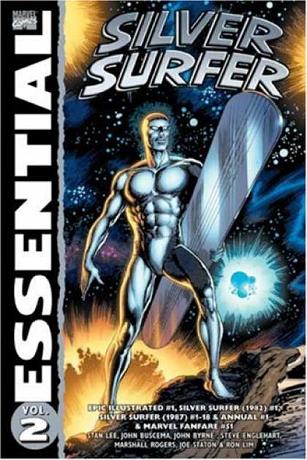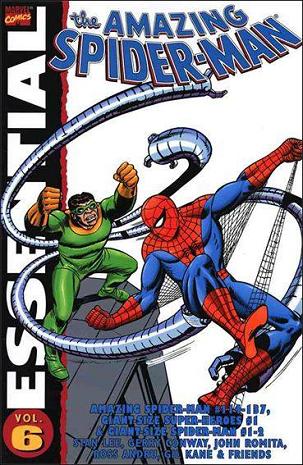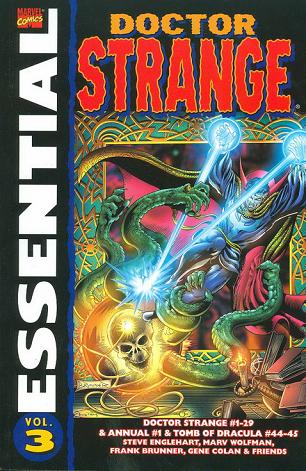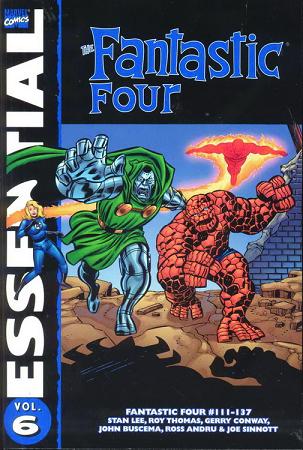
Essential Silver Surfer Vol. 02
Steve Englehart, Marshall Rogers, Joe Staton, Ron Lim and friends
Reprints: Silver Surfer Vol. 2 #1, Silver Surfer v3 #1-18, Annual 1, more (July 1987- December 1988)
Get this for: the Celestial Madonna — four stars
From one classic Steve Englehart series to another, not quite as classic one. The Silver Surver’s second series would be quite different from the original Stan Lee & John Buscema one, if only because Englehart freed him from his imprisonment at Earth in the very first issue. But the main difference was best summed up in an Amazing Heroes observation, that whenever in his original series the Surfer would wax philosophically about man’s inhumanity to man, in his new series he waxes hornily about Shalla Ball, Nova or Mantis…. Englehart made the Surfer more lighthearted, more cosmic than he had been in his old series, while, as the mention of Mantis suggests, also revisiting his own personal obsessions. Joined by his old Batman partner Marshall Rogers on the art, the 1987 Silver Surfer series is quite different from its 1968 predecessor and to me much more interesting.
But Essential Silver Surfer Vol. 02 does not quite start there. While sensibly not including the myriad guest appearances of the Surfer over the years, this volume does start with two stories featuring the old Surfer: a short story from Epic Illustrated and the Stan Lee scripted, John Byrne plotted and pencilled 1982 Silver Surfer one shot. The latter saw Reed Richards freeing the Surfer from his cosmic imprisonement on Earth, return to Zenn-La and his old love Shalla Ball, only to discover his planet almost destroyed and Shalla Ball a prisoner of Mephisto. He manages to free Shalla Ball and revitalise Zenn-La, but at the cost of his freedom, yet again. It’s a good story, but typical of everything that made the original series a failure in the end: the Surfer doesn’t work on Earth.
Englehart understood that and also understood the potential of having a proper space based series, something not really seen at Marvel before. In issue one he got the Surfer off Earth and free of Galactus, in issue two he cut his ties to Zenn-La and Shalla Ball and by issue three he had reintroduced Mantis, seen for the first time since she became the Celestial Madonna, as well as set up the storylines that would drive the series for its first year and beyond. Building on the loss of the Skrulls’ shape-shifting power established in the 1985 Avengers and Fantastic Four annuals, Englehart has the Skrull empire descend in chaos, with one of the pretenders of the throne launching the second Kree-Skrull War. Meanwhile the Elders of the Universe are gunning for the Surfer, wanting to keep him from helping Galactus, who they wanted to kill.
Why they wanted to kill him does not become clear until a few more issues along, as Englehart also draws in the Supreme Intelligence of the Kree and the Infinity Gems, here still called the Soul Gems, into the Elders’ plot. This seems to have run out of steam with #109, as Galactus eats five of the Elders while the other three are drawn into a black hole, but this turns out to be premature. In issue fifteen Ron Lim replaces Marshall Rogers and Joe Staton on the art, while Sue and Reed Richards are recruited by the Surfer to help Galactus recover from his “cosmic indigestion” caused by the Elders of the Universe he ate…
Ron Lim is well suited to the Silver Surfer, which was his breakthrough series as well. He has a good style for cosmic battles and I’ve always liked his art, buff as it is. Not that Marshall Rogers was bad, with his more gracious, elegant style. Inbetween them is Joe Staton, who cut his cosmic teeth on Green Lantern, including a long run with Englehart. I like his art, but not here.
Essential Silver Surfer Vol. 02 ends with a curiosity, an issue of Marvel Fanfare that published what was going to be the first issue of a twelve issue, double sized Silver Surfer limited series, before that metamorphed into a ongoing series. That limited series was also going to be written by Englehart, but with art by John Buscema and with the Surfer left stranded on Earth, but still meeting with Mantis and getting drawn in cosmic developments. It’s an interesting view of what could have been, but fortunately never came to pass.



